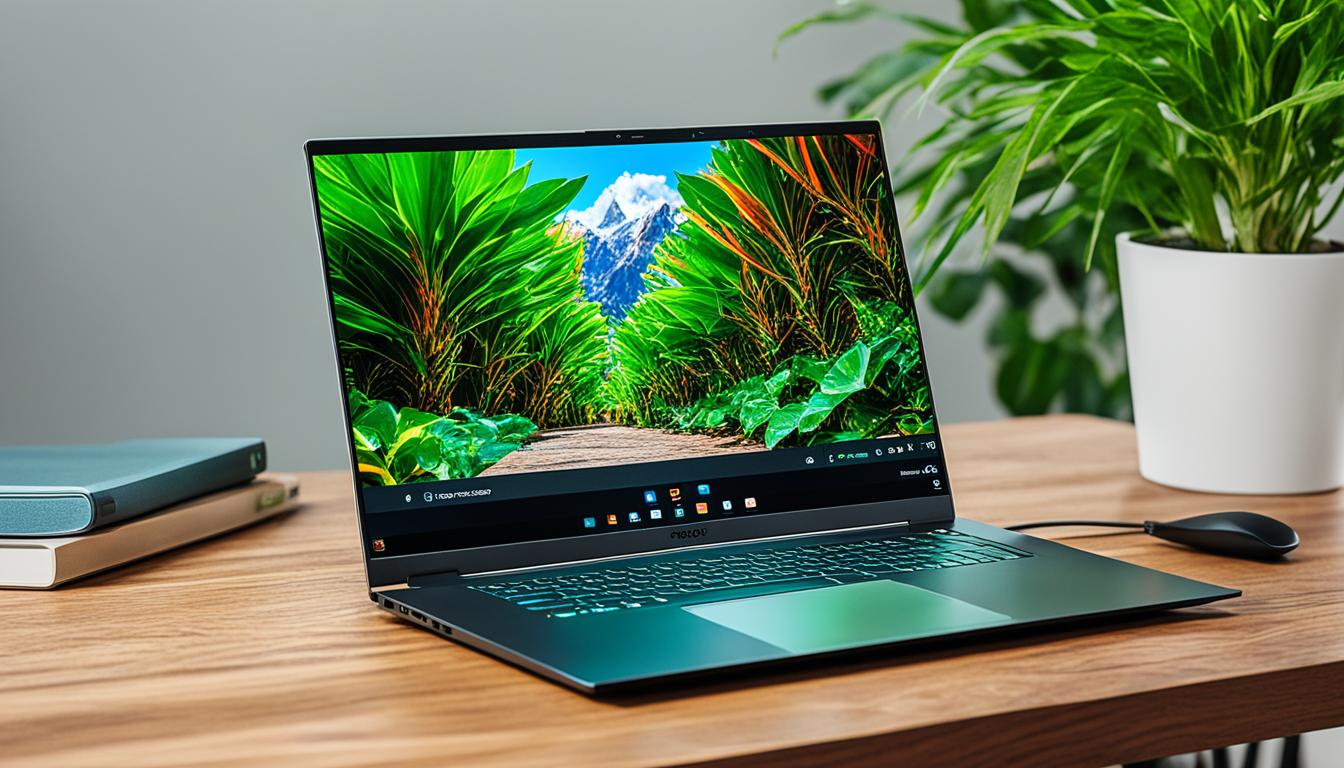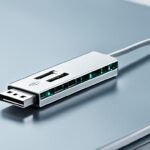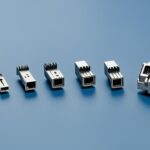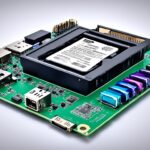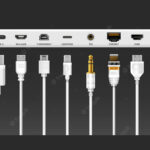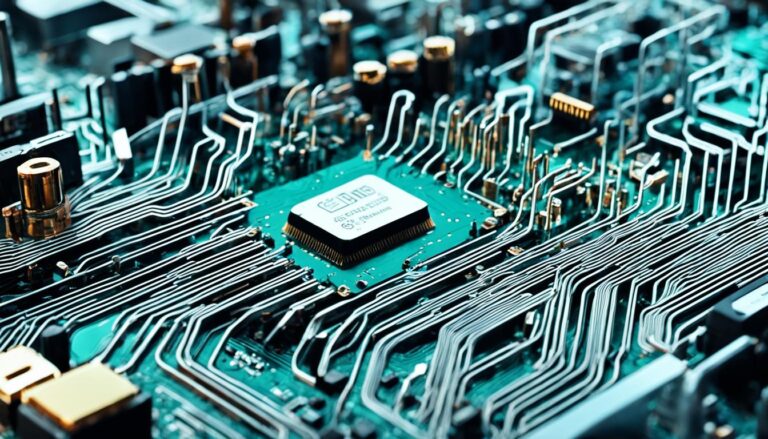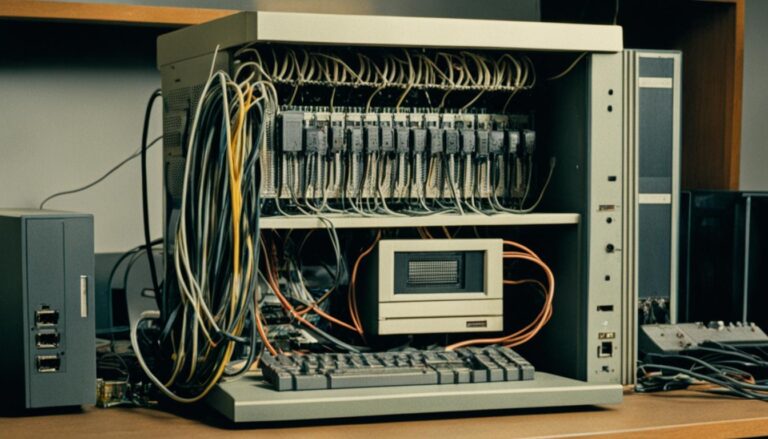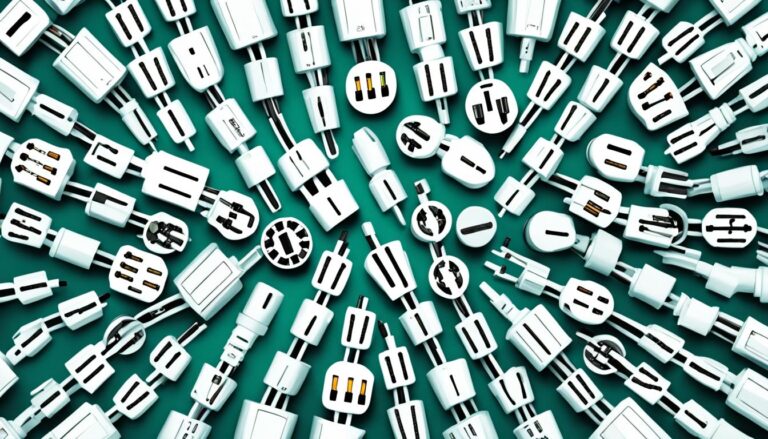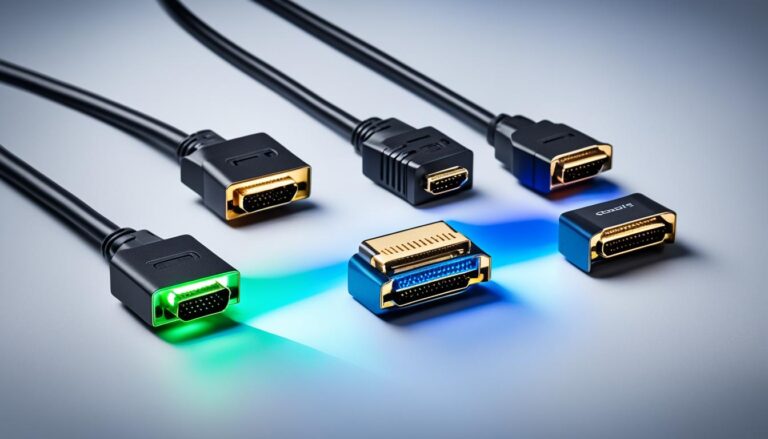When picking a laptop, think about one with a display port. It can make your screen look better and connect easily.
The Importance of Port Selection
Choosing the right ports on a laptop is key. It makes sure you connect to your devices smoothly. It’s important to look at the laptop’s ports before buying. This stops the need to switch cables often. It also makes sure your devices work well with the laptop.
Types of Ports
Laptops have many different ports. Each one has its use. The most common ports include:
- USB Ports: USB ports connect to many devices like hard drives and keyboards.
- Thunderbolt Ports: These ports work faster and can handle more data. They are great for things like external graphics cards.
- HDMI Ports: Use HDMI ports to link laptops to TVs or projectors. They give great sound and picture.
- DisplayPort: This port is for video. It supports high-quality displays and monitors.
- Audio Ports: Through audio ports, connect headphones or mics. They’re used for listening to music or recording.
Look at a laptop’s ports to see if it has what you need. This will tell you if it will work for what you want.
It’s vital to pick the right ports when choosing a laptop. Make sure it has what you need to avoid extra cables. Aim for a laptop that lets you connect all your tools easily.
Having the right ports makes a big difference. It can boost how you work and play. Good ports mean you can use more screens, move data fast, and work with special gadgets.
Now, let’s check out USB against Thunderbolt ports. This will help you pick the best one for you.
USB vs. Thunderbolt: Which Connection Is Right for You?
When connecting your laptop to a display port, you have two choices: USB and Thunderbolt. Both have their unique benefits. Knowing the differences makes it easier to decide what’s best for you.
USB Connection
USB ports are common and work with many types of display ports. They let you connect all sorts of devices, from monitors to external drives. USBs are good for everyday use because they’re reliable.
USB’s big advantage is its broad compatibility. Most gadgets work well with USB, without needing special adapters. They’re also plug-and-play, which means they’re easy to use right away.
Yet, USB might not be the fastest for moving data. USB 3.0 and 3.1 are quick, but still can’t beat Thunderbolt speeds.
Thunderbolt Connection
Thunderbolt ports give you quicker speeds and more data at once compared to USB. They’re great for heavy tasks like video editing or gaming. Thunderbolt also lets you link several devices together, cutting down on extra cables.
This daisy-chaining means fewer ports and hubs are needed, making your space tidier. But, not all gadgets work with Thunderbolt, so check compatibility first.
Choosing between USB and Thunderbolt depends on your needs. For fast speeds and certain devices, go with Thunderbolt. If you need something that works with many devices, USB is reliable and common.
Choosing the right connection for your laptop’s display port matters. Think about what you need, what you’re connecting, and device compatibility. This way, you can pick the best option for you.
Considerations for Apple Users
If you use Apple products, finding a laptop with a compatible display port is key. You need a docking station that works well with your MacBook. Luckily, the market offers several docking stations made just for MacBook users.
These docking stations allow you to connect your MacBook to other screens, gadgets, and devices. They are great for boosting your productivity by expanding what your MacBook can do.
When picking a docking station, check for Thunderbolt 3 ports. These ports enhance your MacBook’s performance and make sure it works well with Apple devices. By using these ports, you can enjoy all the advanced features of your MacBook.
Also, MacBook docking stations usually have extra features. They come with USB ports, HDMI outputs, and SD card readers. These give you more ways to connect different devices and accessories.
| Docking Station | Compatibility | Features |
|---|---|---|
| Docking Station A | MacBook Pro, MacBook Air | Thunderbolt 3, USB ports, HDMI output, SD card reader |
| Docking Station B | MacBook Pro, MacBook Air | Thunderbolt 3, USB-C ports, Ethernet, HDMI output |
| Docking Station C | MacBook Pro, MacBook Air | Thunderbolt 3, USB-C ports, DisplayPort, Audio in/out |
Choosing the right docking station for your MacBook depends on your needs. Think about the kinds of ports you need and any special features that might help your work flow.
To sum up, compatibility is crucial for Apple users. Look for docking stations designed for Apple, with Thunderbolt 3 ports. They offer you many ways to connect and make the most of your MacBook’s features.
ChromeOS Compatibility
If you have a Chromebook, make sure the laptop you pick works with ChromeOS. Many docks work well with Chromebooks. They make connecting stuff easy. But, check if it fits before you buy to avoid issues.
Chromebooks are light, have long battery life, and work well with Google apps. For the best experience, your laptop should match ChromeOS. This means easy connections to monitors, projectors, and more. The right laptop makes everything run smoothly.
Also, when picking a docking station for ChromeOS, find one made for Chromebooks. They often have extra USB ports, internet connections, and can charge your device. These docks fit perfectly with ChromeOS. They help you do more and be more productive.
When looking for a laptop for your Chromebook, think about what you really need. No matter if you’re studying, working, or creating, the right ChromeOS-compatible laptop makes a big difference. It boosts your work and makes your life easier.
Key Considerations for ChromeOS Compatibility:
- Check if the laptop with a display port suits ChromeOS.
- Pick a docking station made for Chromebooks.
- Think about the number and type of ports you need.
- Extra features like charging, USB ports, and internet can make a big difference.
Choosing the right laptop and docking station for ChromeOS means you can work better and smoother.
Portable vs. Stationary Docks: Which is Right for You?
Choosing between a portable or stationary laptop dock? It depends on your needs and work style. Each type has its own benefits. Think about what you need most from your setup.
Portable Docks
Are you always on the move? A portable dock is light and easy to carry. It connects your laptop to other devices anywhere. It’s great for those who need flexibility.
This is perfect for traveling professionals, freelancers, and students. But remember, portable docks have fewer ports. So, you must decide which connections are key for your work.
Stationary Docks
A stationary dock suits a fixed work setting well. It gives you many connection options, like USB and HDMI ports. It’s designed for a permanent setup.
It keeps everything connected without constant unplugging. This is good for a home office, gamers, or multimedia enthusiasts. And it’s less hassle.
If connecting many devices is crucial, consider a stationary dock. It even charges your laptop, reducing the need for many cables.
Choosing the Right Dock for You
Think about your working style and needs. For those always moving, a lightweight portable dock works. But for a fixed space with many devices, a stationary dock is better.
Your choice should match your work habits and device needs. Weigh the convenience and range of connections you need. This way, you’ll find the best dock for your laptop.
Powering Your Laptop Through a Docking Station
Some docking stations let you power and recharge your laptop directly. This means you don’t need many power adapters. It keeps your workspace tidy. To enjoy this, make sure your laptop and docking station are compatible and support this feature.
Using a docking station to power your laptop has many benefits. It cuts down on cable clutter making your desk neater. You’ll manage cables better with just one power source.
It also adds convenience. Especially for those who move their laptops around a lot. You won’t have to plug and unplug your power adapter each time. Just dock your laptop and get to work straight away.
This feature allows for flexible charging too. You can charge your laptop while working or during meetings. The docking station meets all your charging needs.
Moreover, it guarantees a stable power supply. This enhances your computing experience by preventing power issues. It protects your laptop and other devices from damage caused by power fluctuations.
Compatible Devices
Not every laptop with a display port will work with all power-equipped docking stations. It’s vital to check that your laptop and docking station are compatible. Before buying, look at the manufacturer’s specs and recommendations.
Certain docking stations are made for specific laptop brands. For instance, Dell has the WD15 or D6000 docking stations. HP, Lenovo, and Microsoft offer similar solutions. These are designed to power supply your laptop.
When choosing a docking station, think about more than just the power feature. Consider the number of ports, connection types, and other key features for your work.
Conclusion
Choosing a laptop? Look for one with a display port. This feature boosts your viewing joy and ensures easy device connection. Think about what ports you need, USB or Thunderbolt, and if it works with Apple or Chromebook. Consider if you want a dock that is portable or stays in one place. Also, it’s great if it can charge your laptop.
A display port on your laptop brings many advantages. It lets you link to big screens or projectors for better views. Perfect for people who need more screen space or love gaming and movies. Thanks to it, you get clearer and more vibrant visuals. So, your work and fun times get a real upgrade.
Choosing the best laptop with a display port means thinking about what you require. Do you need it to work with Apple or do you use a Chromebook? Think about this. Also, decide if you want a moving dock or a fixed one. And if you hate wires, get a dock that powers your laptop too.
Think carefully about these things to find the right laptop with a display port. It will make looking at things better, connect devices easily, and let you do more with your laptop.
FAQ
What factors should I consider when choosing a laptop with a display port?
When picking a laptop, look at the port types like USB or Thunderbolt. Check if it works well with Apple or Chromebook. Consider if you need it to be portable or not. Also, see if it can power your laptop through the dock.
What is the importance of port selection when choosing a laptop with a display port?
Port selection matters a lot. It decides how many and what kind of ports the laptop has. You need to make sure it has all you need for your devices. This avoids the hassle of swapping cables too often.
What are the differences between USB and Thunderbolt connections for laptops with display ports?
USB ports are quite common and fit most devices. Thunderbolt ports, however, are speedier and handle more data. Choosing between them depends on your device needs and compatibility.
Is it important to consider Apple compatibility when choosing a laptop with a display port?
If you’re an Apple user, make sure the laptop is MacBook-friendly. Opt for docks that support Apple to connect smoothly.
How can I verify the compatibility of a laptop with a display port with ChromeOS?
For Chromebook users, it’s crucial the laptop with a display port works with ChromeOS. Many docks do, but always double-check before buying.
What are the advantages of portable and stationary docks for laptops with display ports?
Portable docks are great for travel, as they’re lighter and smaller. Stationary docks fit a fixed setup better but are bigger. Remember, portable docks might have fewer ports.
Can a docking station power and recharge my laptop with a display port?
Some docks can power up and recharge your laptop. Always check if both your laptop and the dock support this. It’s handy and cuts down on power cables.
